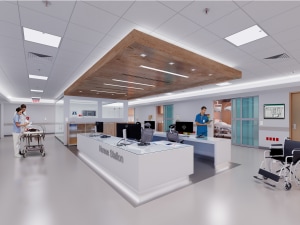LLLC stands for Luminaire Level Lighting Controls. LLLCs are a trend in commercial lighting that can improve occupant comfort and space utilization.
Specifically, LLLCs combine LEDs, controls, connectivity, and data to create a flexible lighting system. Often built into LLLCs are controls strategies such as occupancy sensing, daylight harvesting, continuous dimming, and more.
LLLCs are the fastest-growing controls option in indoor lighting as a whole. And they’re tracking in the commercial market segment, especially for mid- to small-size buildings.
An Alternative to a Centralized Control System
While lighting controls have not yet gained popularity in all markets, LLLCs’ benefits make them attractive to a broader audience.
Instead of a centralized control system, LLLCs are a distributed, luminaire-level control type of system.
LLLCs can be controlled individually, independent from all the other luminaires in a space, while also programmed to be part of a group of luminaires or assigned to a control device, such as a wireless wallstation.
LLLCs can dim, raise lighting levels based on assigned wallstations, room daylight levels, or room occupancy.
Some LLLC systems allow the wallstations to be programmed with scenes adapted to space usage or a specific task. This strategy maximizes incremental control within very small areas while providing savings during the installation phase.
Recently, LLLCs have also become part of emergency lighting solutions for buildings. By integrating EM-enabled wireless luminaire-integrated sensors into a connected building, one can complete monthly testing in less time with the press of a button on a computer or mobile device. Learn more here.
Flexibility to Adapt to Space Changes
Today’s commercial buildings are more dynamic, so space changes are more common than ever before. Rooms that can be repurposed or redesigned without the need for rewiring luminaires or wallstations are very attractive to commercial building owners and renters.
The flexibility that LLLC systems provide for future space changes means everything can be reprogrammed to adapt to new needs, including a new layout. New luminaire groups can be created for new daylight level harvesting, occupancy triggers, and schedules. Using data collected by the lighting equipment, lighting can be adjusted for additional energy optimization or to better serve users’ presence or the tasks required.
There’s also a trend in LLLC projects to use Bluetooth communication technology. Its most significant benefit over other mesh technology networking solutions, such as ZigBee, is that it allows installers or end-users to program light behavior from a smartphone.
Less Risk Than Wired Lighting Control
LLLC systems require fewer products to be specified and installed than do wired lighting controls; if for whatever reason things don’t go as originally planned, it’s easier to recover and close the project for both specifiers and installers.
Simple, scalable, secure solutions such as LLLCs are preferable because they help designers, electrical contractors, and facility managers keep installation and commission costs under control.
Of Course, There Are Challenges
There are different types of LLLC systems available for different types of customer needs. Some address local codes while providing further energy savings; others provide advanced lighting information such as level scheduling and maintenance; and still others go beyond lighting to provide information such as hospital room occupancy and equipment tracking.
All these types of control systems come with their own set of challenges.
Connected lighting, for example, is a type of system that brings the most value for the end-customer; however, specification can be challenging because of unfamiliarity with new technologies, new local building codes, and trends leading to future needs to which the system will have to adapt and support, etc.
Installers face similar issues. Contractors have to learn how to install products that are low DC voltage powered and require different cables; that include dual switches for color tuning; or they need to install luminaires that communicate to programmable wall mount stations with a ZigBee mesh network or via ethernet cables.
Once a system is successfully executed, the installer will have to validate that the lighting equipment is functioning as expected and that may require extra steps.
For example, they may have to install a controller panel that requires network connection; or they may need to install a gateway to connect to a mobile network. They’ll also need access to the system which requires an account and some time to download an app.
Education is Key
Lowering the risks presented by the challenges mentioned above can be achieved by learning from industry-related organizations and system manufacturers.
Specifiers and general and electrical contractors working on LLLC projects, especially those involving communication to a server, need to understand the technology and outcomes before getting started. Facility managers who’ll be using the system functionalities also need to get up to speed.
For example, basic network knowledge is key to commissioning the lighting equipment when connecting the gateway to the internet. Sometimes lighting equipment is installed before IT-related equipment; in that case, installers, such as electrical contractors, need basic network/router knowledge to install a temporary "hotspot" through a mobile network device.
Fortunately, the Technical Information is Readily Available
There are many online sources of pertinent education – including lighting control manufacturers’ websites where you might even find access to an inhouse expert who’ll answer your general questions.
It’s not difficult to find online classes and webinars that are typically more complete than what can be found on YouTube. YouTube is a great resource, but when your subject matter is highly technical, it’s probably better to look for more robust sources of education.
The more you learn about LLLCs, the more impressed you’ll be with this alternative to centralized control systems. It's well worth taking the time to dive deeper into the installation and programming of LLLCs so you’ll be ready when a project calls for it.
Talk to a Lighting Control Professional
What will artificial intelligence will bring to LLLC?
Integrating Artificial Intelligence (AI) with sensors will improve occupant motion detection significantly. One of the most impactful enhancements for connected sensors will be algorithms that provide a deeper understanding of occupancy and activities.
AI's machine-learning capabilities will allow sensors to learn and adapt continuously. By analyzing historical data and real-time sensor readings, AI will adjust detection thresholds to account for regular non-human related movement (e.g., seasonal variations in sunlight patterns or trees with and without leaves), daily routines within a building or on streets (e.g., high activity period, speeding car at night). AI will also be able to differentiate between single person and multiple occupants within a space.
The result will be consistent accuracy and adaption to light levels, the avoidance of needing manual recalibration, and a reduction of false positives.
As part of a connected system, this granular data can be used for even more personalized lighting adjustments. For instance, the system could automatically adjust light intensity and color temperature based on the detected activity, promoting focus during work hours, or providing a more relaxed atmosphere in meeting areas or mimicking the daylight spectrum.
A crucial benefit of AI-powered occupancy detection is ensuring user privacy. Anonymization and edge computing will allow the system to process data – locally on the sensor device or at the network edge – without compromising individuals’ identity. To further safeguard user privacy, AI algorithms can be designed to process occupancy data anonymously.


